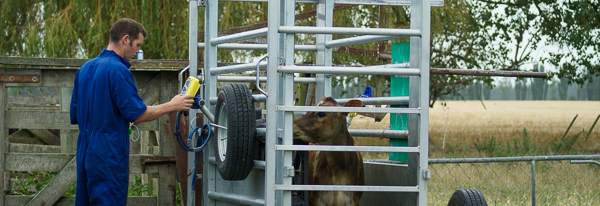
Meeting target live weights of heifers, from weaning through to their first lactation, can mean more milk in the vat.
Research conducted by Rhiannon Handcock from Massey University in 2019 is represented in the graph below. The blue line on the left shows how much milk heifers produce in their first lactation in relation to what they weighed when they were 3 months old. A heifer weighing 50kg more at 3 months of age will produce an extra 40kgMS more than her lighter counterpart. And the relationship does continue as a calf gets older, so it is not good enough to have good growth in one year and neglect the next. This highlights the importance of regular monitoring of your heifers.

Monthly weighing of heifers is important to ensure growth rates are not dropping for any particular reason. The goal is to identify the number of calves below target, because the % below target requires more focus than the often-scrutinised average weight. Averages can lull you into a false sense of security, and a figure of >10% below target weights is a concern, and the reasons need to be investigated.
After weaning, sometimes our calves, sent off to run-off blocks, can get a little forgotten, and all the hard work you have put into your replacements can easily be lost if effort is not made to monitor them. All too often in the summer, we are called to see sick R1s, and, nearly always, the cause is something that could have been prevented.
Firstly, whether you look after the calves yourself or someone else is at a run-off, a monthly weighing programme is essential. Any longer between weighs can mean a drop in growth rates is missed. Weighing allows you to identify the number of calves below target. ‘% below target’ is what we need to focus on, NOT the ‘average weight’ as many do. If you have >10% below target then you should be looking into the reasons why – it is very achievable to have 0-2% of your calves under target by January if they are also fed well before weaning.
The monthly weigh often fits in well with your drenches. Whether you are on irrigated land, how heavily stocked the land is, and if other stock graze it, are all factors that may affect your drench intervals, so please do ask us how often and with what you should be drenching. As a rule, oral drenches are best for gut worms in dairy heifers, for as long as you can manage to drench them. Depending on your area, we may also need to add in a pour-on or injectable drench that has persistent action against lungworm.
Trace elements, especially copper, selenium and cobalt, will need to be given, and if you have not tested the animals it is best to check by doing some bloods and/or liver biopsies as every farm will be different. Supplements come in many different forms (eg mineral licks, prills, dosatron mixes, injections, boluses), and it is best to discuss with your vet which would be best for you. The majority of ‘sick calves’ we see in the summer also have a concurrent trace element deficiency; this results in them having poor immune systems which is often why diseases such as Yersinia (bacteria causing scours) gain a foothold.
Coccidiosis is another condition we see frequently in calves from August to November. Coccidiosis is caused by a parasite which damages the intestines. Eggs can last 2 years on the pasture, so we see more of this disease where calf paddocks have been grazed repeatedly over the years. Calves with scour patches on their backsides and coats that do not look as glossy as usual may have cocci. We can identify cocci with a simple faecal egg count test. The impact on growth rates can be huge, so prevention early on is recommended.
Vetlife have a number of weigh crates located throughout the practice, and we can provide a weighing service should you not have the resources or equipment. A regular weighing programme can be developed with your local clinic and will involve your Vetlife veterinarian and/or technician. It may involve monthly weighing, or it can be scaled up to administer worming treatments, vaccinations, trace element testing and supplementation. Following all weigh visits, an analysis of weights will be generated and compiled in a report covering weight gain, mineral status, parasitic control, and any further advice as necessary. The choice is yours. The key take-home message is that regular monitoring will ensure your heifers continue to meet target liveweights so that they can enter the herd and produce maximal returns for you and your farming operation.
A youngstock health plan can be invaluable to ensure that you do not forget to give the animals the essential treatments described above, and it gives you that opportunity to discuss which options will be best for you. Book in a visit with Vetlife soon, to ensure your R1s will get the best care they can have over the coming year.